2007 CHEVROLET IMPALA lock
[x] Cancel search: lockPage 432 of 460
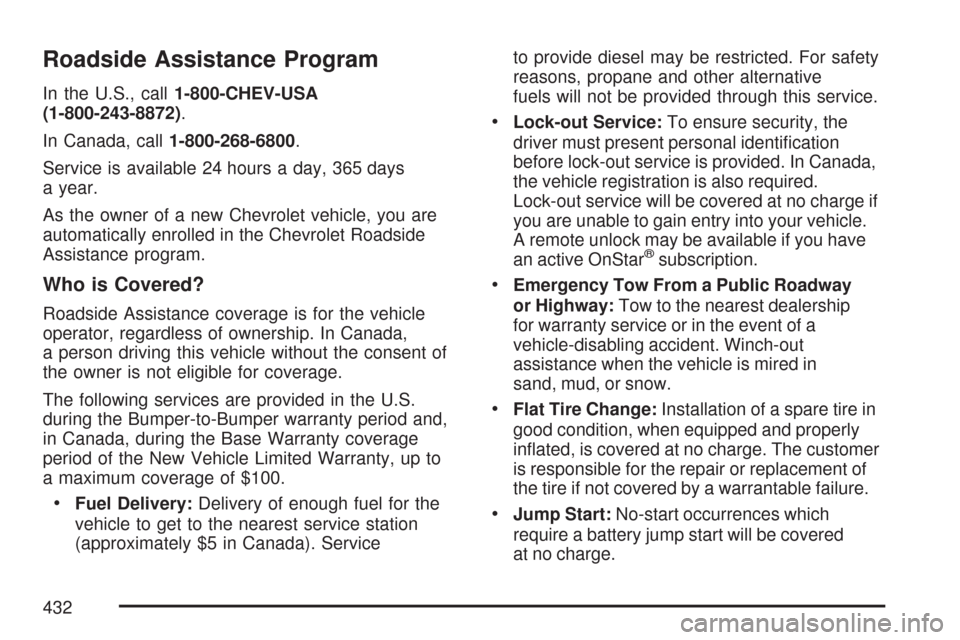
Roadside Assistance Program
In the U.S., call1-800-CHEV-USA
(1-800-243-8872).
In Canada, call1-800-268-6800.
Service is available 24 hours a day, 365 days
a year.
As the owner of a new Chevrolet vehicle, you are
automatically enrolled in the Chevrolet Roadside
Assistance program.
Who is Covered?
Roadside Assistance coverage is for the vehicle
operator, regardless of ownership. In Canada,
a person driving this vehicle without the consent of
the owner is not eligible for coverage.
The following services are provided in the U.S.
during the Bumper-to-Bumper warranty period and,
in Canada, during the Base Warranty coverage
period of the New Vehicle Limited Warranty, up to
a maximum coverage of $100.
Fuel Delivery:Delivery of enough fuel for the
vehicle to get to the nearest service station
(approximately $5 in Canada). Serviceto provide diesel may be restricted. For safety
reasons, propane and other alternative
fuels will not be provided through this service.
Lock-out Service:To ensure security, the
driver must present personal identi�cation
before lock-out service is provided. In Canada,
the vehicle registration is also required.
Lock-out service will be covered at no charge if
you are unable to gain entry into your vehicle.
A remote unlock may be available if you have
an active OnStar
®subscription.
Emergency Tow From a Public Roadway
or Highway:Tow to the nearest dealership
for warranty service or in the event of a
vehicle-disabling accident. Winch-out
assistance when the vehicle is mired in
sand, mud, or snow.
Flat Tire Change:Installation of a spare tire in
good condition, when equipped and properly
in�ated, is covered at no charge. The customer
is responsible for the repair or replacement of
the tire if not covered by a warrantable failure.
Jump Start:No-start occurrences which
require a battery jump start will be covered
at no charge.
432
Page 443 of 460
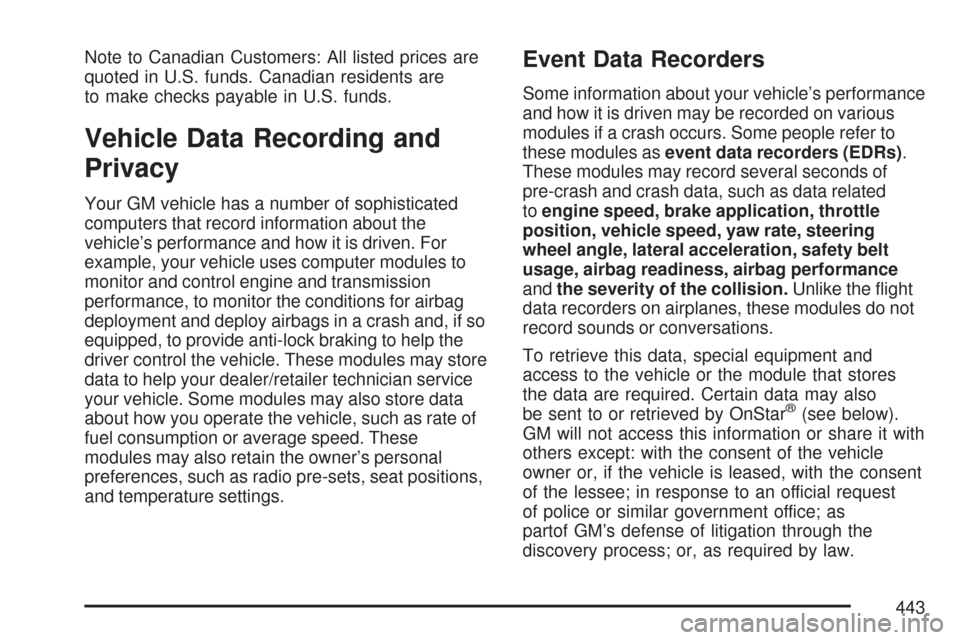
Note to Canadian Customers: All listed prices are
quoted in U.S. funds. Canadian residents are
to make checks payable in U.S. funds.
Vehicle Data Recording and
Privacy
Your GM vehicle has a number of sophisticated
computers that record information about the
vehicle’s performance and how it is driven. For
example, your vehicle uses computer modules to
monitor and control engine and transmission
performance, to monitor the conditions for airbag
deployment and deploy airbags in a crash and, if so
equipped, to provide anti-lock braking to help the
driver control the vehicle. These modules may store
data to help your dealer/retailer technician service
your vehicle. Some modules may also store data
about how you operate the vehicle, such as rate of
fuel consumption or average speed. These
modules may also retain the owner’s personal
preferences, such as radio pre-sets, seat positions,
and temperature settings.
Event Data Recorders
Some information about your vehicle’s performance
and how it is driven may be recorded on various
modules if a crash occurs. Some people refer to
these modules asevent data recorders (EDRs).
These modules may record several seconds of
pre-crash and crash data, such as data related
toengine speed, brake application, throttle
position, vehicle speed, yaw rate, steering
wheel angle, lateral acceleration, safety belt
usage, airbag readiness, airbag performance
andthe severity of the collision.Unlike the �ight
data recorders on airplanes, these modules do not
record sounds or conversations.
To retrieve this data, special equipment and
access to the vehicle or the module that stores
the data are required. Certain data may also
be sent to or retrieved by OnStar
®(see below).
GM will not access this information or share it with
others except: with the consent of the vehicle
owner or, if the vehicle is leased, with the consent
of the lessee; in response to an official request
of police or similar government office; as
partof GM’s defense of litigation through the
discovery process; or, as required by law.
443
Page 444 of 460
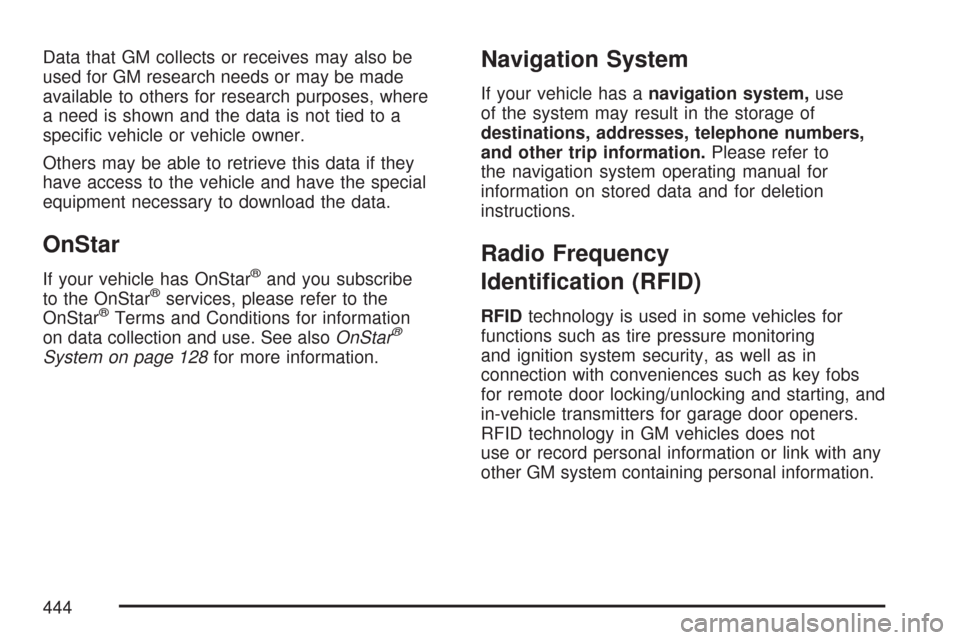
Data that GM collects or receives may also be
used for GM research needs or may be made
available to others for research purposes, where
a need is shown and the data is not tied to a
speci�c vehicle or vehicle owner.
Others may be able to retrieve this data if they
have access to the vehicle and have the special
equipment necessary to download the data.
OnStar
If your vehicle has OnStar®and you subscribe
to the OnStar®services, please refer to the
OnStar®Terms and Conditions for information
on data collection and use. See alsoOnStar®
System on page 128for more information.
Navigation System
If your vehicle has anavigation system,use
of the system may result in the storage of
destinations, addresses, telephone numbers,
and other trip information.Please refer to
the navigation system operating manual for
information on stored data and for deletion
instructions.
Radio Frequency
Identi�cation (RFID)
RFIDtechnology is used in some vehicles for
functions such as tire pressure monitoring
and ignition system security, as well as in
connection with conveniences such as key fobs
for remote door locking/unlocking and starting, and
in-vehicle transmitters for garage door openers.
RFID technology in GM vehicles does not
use or record personal information or link with any
other GM system containing personal information.
444
Page 445 of 460
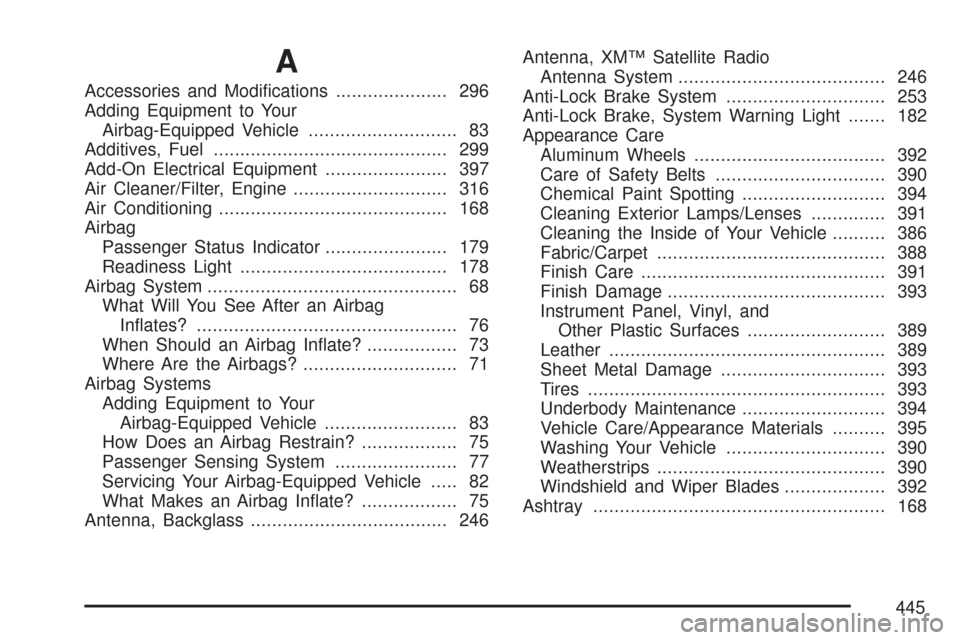
A
Accessories and Modi�cations..................... 296
Adding Equipment to Your
Airbag-Equipped Vehicle............................ 83
Additives, Fuel............................................ 299
Add-On Electrical Equipment....................... 397
Air Cleaner/Filter, Engine............................. 316
Air Conditioning........................................... 168
Airbag
Passenger Status Indicator....................... 179
Readiness Light....................................... 178
Airbag System............................................... 68
What Will You See After an Airbag
In�ates?................................................. 76
When Should an Airbag In�ate?................. 73
Where Are the Airbags?............................. 71
Airbag Systems
Adding Equipment to Your
Airbag-Equipped Vehicle......................... 83
How Does an Airbag Restrain?.................. 75
Passenger Sensing System....................... 77
Servicing Your Airbag-Equipped Vehicle..... 82
What Makes an Airbag In�ate?.................. 75
Antenna, Backglass..................................... 246Antenna, XM™ Satellite Radio
Antenna System....................................... 246
Anti-Lock Brake System.............................. 253
Anti-Lock Brake, System Warning Light....... 182
Appearance Care
Aluminum Wheels.................................... 392
Care of Safety Belts................................ 390
Chemical Paint Spotting........................... 394
Cleaning Exterior Lamps/Lenses.............. 391
Cleaning the Inside of Your Vehicle.......... 386
Fabric/Carpet........................................... 388
Finish Care.............................................. 391
Finish Damage......................................... 393
Instrument Panel, Vinyl, and
Other Plastic Surfaces.......................... 389
Leather.................................................... 389
Sheet Metal Damage............................... 393
Tires........................................................ 393
Underbody Maintenance........................... 394
Vehicle Care/Appearance Materials.......... 395
Washing Your Vehicle.............................. 390
Weatherstrips........................................... 390
Windshield and Wiper Blades................... 392
Ashtray....................................................... 168
445
Page 446 of 460

Audio System.............................................. 215
Audio Steering Wheel Controls................. 243
Backglass Antenna................................... 246
Care of Your CD Player........................... 245
Care of Your CDs.................................... 245
Radio with CD................................219, 225
Setting the Time...................................... 216
Theft-Deterrent Feature............................ 243
Understanding Radio Reception............... 244
XM™ Satellite Radio Antenna System...... 246
Automatic Door Lock................................... 100
Automatic Transaxle
Fluid........................................................ 317
Operation................................................. 116
B
Backglass Antenna...................................... 246
Battery........................................................ 337
Electric Power Management..................... 165
Run-Down Protection............................... 166
Before Leaving on a Long Trip.................... 269Brake
Emergencies............................................ 255
Parking.................................................... 120
Brakes........................................................ 334
System Warning Light.............................. 181
Braking....................................................... 252
Braking in Emergencies............................... 255
Break-In, New Vehicle................................. 111
Bulb Replacement....................................... 343
Halogen Bulbs......................................... 344
Headlamp Aiming..................................... 343
Headlamps, Front Turn Signal,
Sidemarker, and Parking Lamps........... 344
License Plate Lamps................................ 348
Replacement Bulbs.................................. 349
Taillamps, Turn Signal, Sidemarker,
Stoplamps, and Back-Up Lamps........... 346
Buying New Tires........................................ 366
446
Page 448 of 460

Climate Control System............................... 168
Air Filter, Passenger Compartment........... 173
Outlet Adjustment..................................... 172
Clock.......................................................... 216
Collision Damage Repair............................. 437
Comfort Guides, Rear Safety Belt................. 37
Compact Spare Tire.................................... 385
Compass..................................................... 197
Content Theft-Deterrent............................... 107
Control of a Vehicle..................................... 252
Convenience Net......................................... 145
Coolant
Engine Temperature Gage........................ 184
Engine Temperature Warning Light........... 183
Heater, Engine......................................... 115
Cooling System........................................... 326
Courtesy Lamps.......................................... 163
Cruise Control............................................. 157
Cruise Control Light.................................... 189
Cupholder(s)................................................ 144
Customer Assistance Information
Courtesy Transportation........................... 434
Customer Assistance for
Text Telephone (TTY) Users................. 430
Customer Assistance Offices.................... 430Customer Assistance Information (cont.)
Customer Satisfaction Procedure.............. 426
GM Mobility Reimbursement Program...... 431
Reporting Safety Defects to
General Motors..................................... 441
Reporting Safety Defects to the
Canadian Government.......................... 441
Reporting Safety Defects to the
United States Government.................... 440
Roadside Assistance Program.................. 432
Service Publications
Ordering Information.............................. 441
D
Daytime Running Lamps/Automatic
Headlamp System.................................... 162
Defensive Driving........................................ 248
Delayed Entry Lighting................................ 164
Delayed Exit Lighting................................... 165
Delayed Headlamps.................................... 162
DIC Compass.............................................. 197
Disc, MP3................................................... 236
Doing Your Own Service Work.................... 297
Dome Lamp................................................ 164
448
Page 449 of 460

Door
Automatic Door Lock................................ 100
Locks......................................................... 98
Power Door Locks..................................... 99
Programmable Automatic Door Unlock..... 100
Rear Door Security Locks........................ 100
Driver
Position, Safety Belt................................... 24
Driver Information Center (DIC)................... 190
DIC Operation and Displays..................... 191
DIC Vehicle Customization....................... 208
DIC Warnings and Messages................... 199
Driving
At Night................................................... 263
City.......................................................... 267
Defensive................................................. 248
Drunken................................................... 249
Freeway................................................... 268
Hill and Mountain Roads.......................... 270
In Rain and on Wet Roads...................... 264
Rocking Your Vehicle to Get it Out.......... 277
Winter...................................................... 272E
EDR ............................................................ 443
Electrical System
Add-On Equipment................................... 397
Fuses and Circuit Breakers...................... 398
Headlamp Wiring..................................... 397
Instrument Panel Fuse Block................... 398
Power Windows and Other
Power Options...................................... 398
Underhood Fuse Block............................. 400
Windshield Wiper Fuses........................... 397
Engine
Air Cleaner/Filter...................................... 316
Check and Service Engine Soon Light..... 185
Coolant.................................................... 320
Coolant Heater......................................... 115
Coolant Temperature Gage...................... 184
Coolant Temperature Warning Light.......... 183
Drive Belt Routing.................................... 420
Engine Compartment Overview................ 306
Exhaust................................................... 124
449
Page 450 of 460
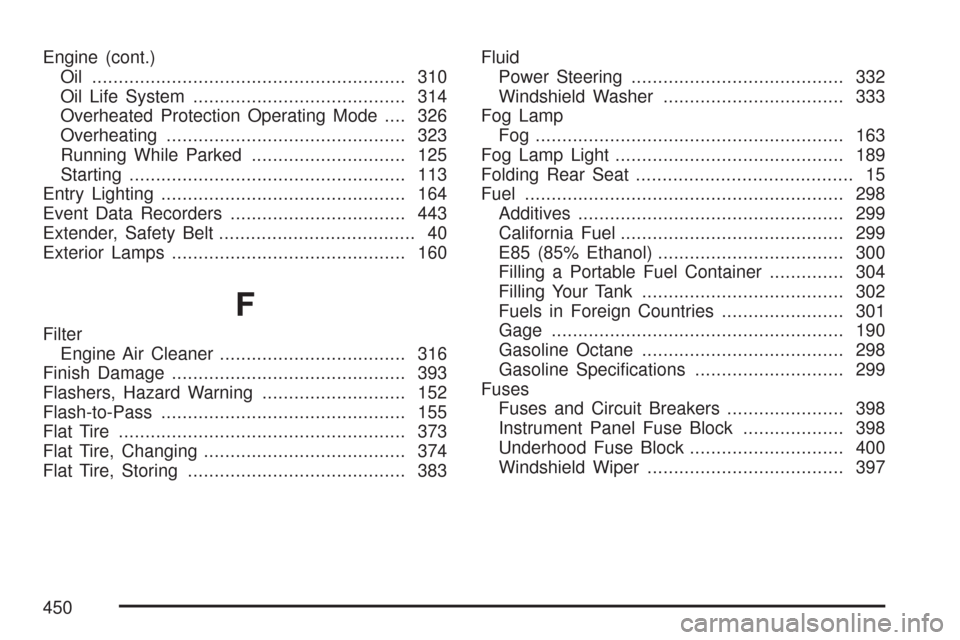
Engine (cont.)
Oil ........................................................... 310
Oil Life System........................................ 314
Overheated Protection Operating Mode.... 326
Overheating............................................. 323
Running While Parked............................. 125
Starting.................................................... 113
Entry Lighting.............................................. 164
Event Data Recorders................................. 443
Extender, Safety Belt..................................... 40
Exterior Lamps............................................ 160
F
Filter
Engine Air Cleaner................................... 316
Finish Damage............................................ 393
Flashers, Hazard Warning........................... 152
Flash-to-Pass.............................................. 155
Flat Tire...................................................... 373
Flat Tire, Changing...................................... 374
Flat Tire, Storing......................................... 383Fluid
Power Steering........................................ 332
Windshield Washer.................................. 333
Fog Lamp
Fog .......................................................... 163
Fog Lamp Light........................................... 189
Folding Rear Seat......................................... 15
Fuel............................................................ 298
Additives.................................................. 299
California Fuel.......................................... 299
E85 (85% Ethanol)................................... 300
Filling a Portable Fuel Container.............. 304
Filling Your Tank...................................... 302
Fuels in Foreign Countries....................... 301
Gage....................................................... 190
Gasoline Octane...................................... 298
Gasoline Speci�cations............................ 299
Fuses
Fuses and Circuit Breakers...................... 398
Instrument Panel Fuse Block................... 398
Underhood Fuse Block............................. 400
Windshield Wiper..................................... 397
450